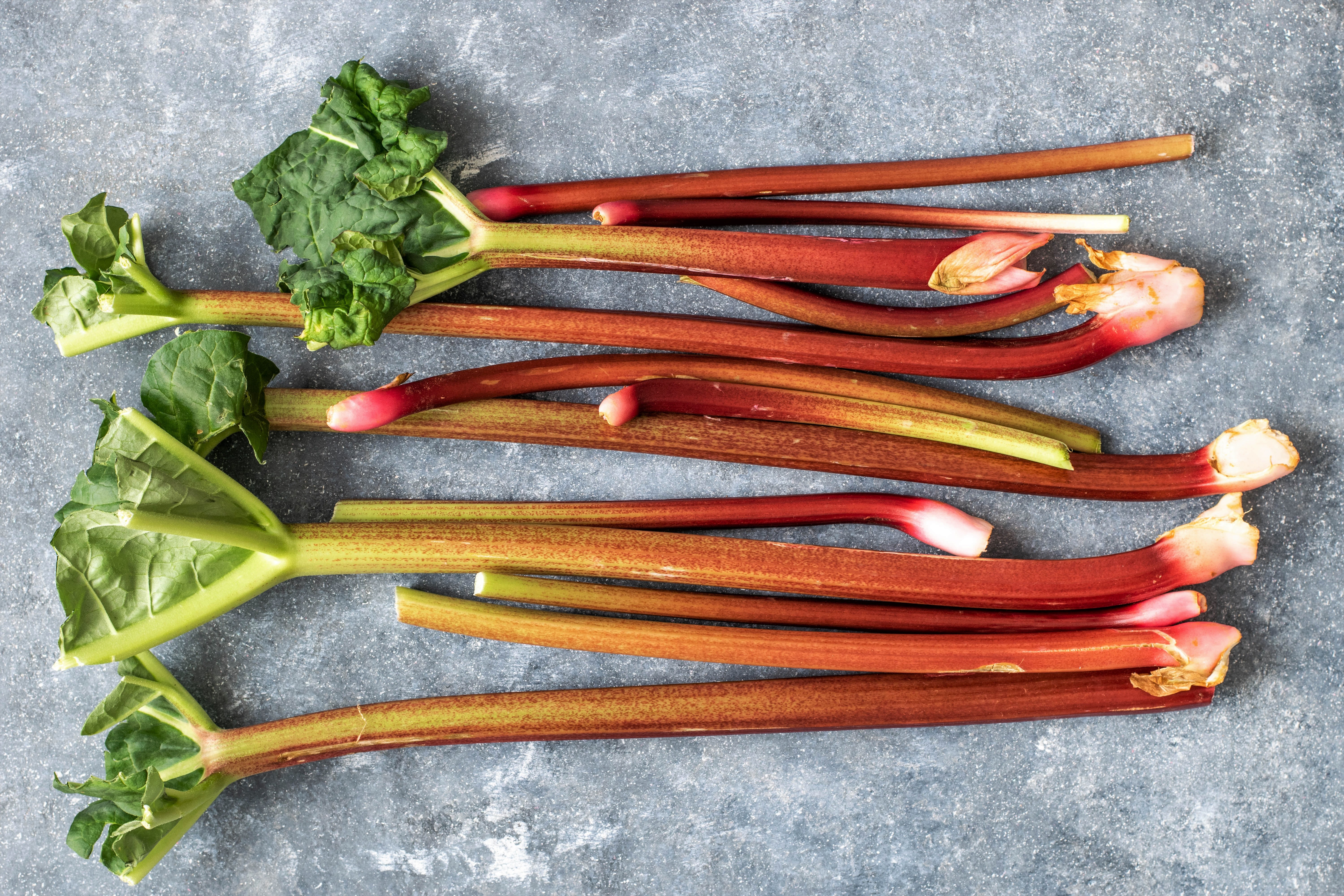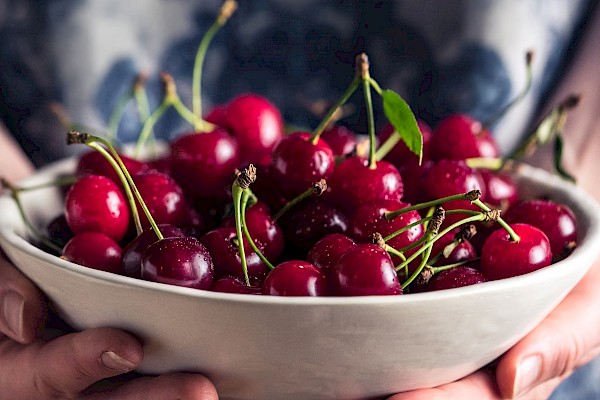Rhubarb
It’s rhubarb time! The Swiss rhubarb season runs from mid-April to the end of June. Rhubarb (Rheum rhabarbarum) is a member of the Polygonaceae family and is related to sorrel. The red-green stalks contain many healthy substances and can grow up to 70 cm long, while the plant itself can reach up to 2 metres. Despite rhubarb’s many health-giving properties, the plant is widely believed to be poisonous – is this really true and, if so, what do you need to bear in mind to eat rhubarb without coming to harm?
As well as fascinating facts about rhubarb, we will also give you a delicious recipe to start the season with!
Fruit or vegetable?
Because we usually prepare the red-green, fruitily sour stalks as a fruit, many people do not realise that the rhubarb plant is actually a vegetable. But this is not the case everywhere in the world! In the USA, for example, rhubarb is considered a fruit.
23 rhubarb plant varieties
We currently know of 23 different varieties of rhubarb around the world. In mid-April, when the harvesting period is just beginning, rhubarb should have a milder flavour. If you are afraid of taking a very sour bite, then we advise you to eat rhubarb when the season starts if possible. Furthermore, you should reach for the red varieties if you prefer a sweeter flavour, because they taste somewhat sweeter than their green cousins.
Rhubarb has a fruity-sour flavour because it contains fruit acids such as citric, malic and oxalic acid. Although all varieties contain the same fruit acids, their flavours couldn’t be more different. The nuances range from extremely sour to bitter to gently sweet – there is a suitable taste experience for everyone!
The different rhubarb varieties can be divided into different categories. The first contains varieties with green skin and green flesh. These are characterised by a very sour flavour and are therefore not popular with many people. In addition, they are high in oxalic acid, which can trigger the symptoms of poisoning in large quantities. Therefore green rhubarb varieties should be avoided by sensitive people and people with gout or kidney problems. Here is a list of the best-known green rhubarb varieties:
The more mellow varieties also have green flesh, but reddish skin. While the red-fleshed varieties score with a sweeter taste, the greener varieties are considered to have higher yields. Varieties with red skin and red flesh are accordingly the sweetest. The following red rhubarb varieties are among the most popular:
Beside the variety, as already mentioned, the time of harvesting also plays an important role in the rhubarb’s flavour. Traditionally rhubarb is only harvested until 24 June. After that the oxalic acid content is considered too high for it to be consumed safely. Correspondingly, an earlier harvest contains less oxalic acid, and the younger stalks harvested in April and May are usually softer and more tender.
What healthy substances does rhubarb contain?
Rhubarb is popular not just for its low calorie count (only around 20 kilocalories per 100 grams), but also for containing minerals such as iron, potassium and phosphorus. Moreover, the popular vegetable also contains vitamin C and fibre.
Oxalic acid – dangerous or even poisonous?
Rhubarb is a vegetable with a high oxalic acid content – approximately 460 milligrams per 100 grams. Oxalic acid is a dicarboxylic acid that occurs primarily in plant foods, but is also made in the body by the metabolism. Oxalic acid is found in plants in compounds of ammonium, potassium, sodium and magnesium ions, called oxalates.
In large quantities, oxalic acid can trigger symptoms of poisoning. Due to its high concentration of oxalic acid, therefore, rhubarb is poisonous. However, when correctly prepared, the vegetable is entirely harmless to healthy people. A large amount of the acid is in the rhubarb leaves, which is why they should be removed without fail and not eaten. What’s more, the oxalic acid content of rhubarb can be reduced by cooking it. When cooked, some of the oxalic acid passes into the cooking water, which should always be drained off and never consumed. In addition, only using the reddish part of the stalks will help – depending on the variety. Moreover, rhubarb should always be eaten cooked or fermented, and never raw, because it contains anthraquinone, which stimulates the intestines and acts as a laxative.
The health benefits of rhubarb
Rhubarb demonstratively benefits human health in several ways. The high fibre content, important for digestion and gut health, means rhubarb is effective against constipation and additionally, that it provides basic regulation of bowel activity. Mood-boosting properties are also ascribed to rhubarb.
Tips for storing rhubarb
After harvesting, rhubarb quickly loses water, which is why it should be processed while as fresh as possible. However, if you have no time right now and would like to store your rhubarb for a little while, you can do this for a few days in the fridge with no problems. If you want to keep your rhubarb for longer, then you can simply freeze it. If you do so, you should make sure that you freeze the rhubarb as soon as possible after it is harvested, as otherwise it can lose vitamins.
Our recipe tip
Swiss-style rhubarb trifle
(Ingredients for 4 people)
- 500 g rhubarb
- 2 tablespoons strawberry jam
- 2 tablespoons pear butter or honey
- 2 tablespoons hot water
- 80 g wholegrain rusks (approximately 14)
Crème:
- 400 ml milk
- 1 vanilla pod
- 2 eggs
- 10 g cornflour
- 50 g sugar
Method: bring the milk to the boil and remove from the heat. Cut the vanilla pod down the middle, scrape out the seeds with a knife and add everything to the milk. Leave to infuse for approximately 10 minutes, then remove the vanilla pod. Mix together the eggs, cornflour and sugar, and add the mixture to the milk. Then heat the milk mixture on a low heat and stir constantly until it is almost boiling. Take the pan off the heat. Peel the rhubarb and cut into dice. Then put the rhubarb into another pan and bring to the boil with the honey or pear butter and simmer for approximately 3 minutes. Blend the strawberry jam with the water. Line a gratin dish with the rusks to fully cover the bottom. Then brush the rusks with the thinned strawberry jam. Spread the rhubarb over that and then pour over the vanilla cream. Leave to infuse for approximately 30 minutes.
(Source)
References:
Scientific knowledge: herbal medicine. Rhubarb. Available on: https://www.gesundheitswissen.de/pflanzenheilkunde/rhabarber/
Xiang, H., Zuo, J., Guo, F. et al. (2020). What we already know about rhubarb: a comprehensive review. Chin Med. 15, 88.
 subscribe to newsletter
subscribe to newsletter


